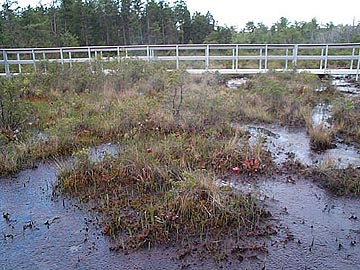
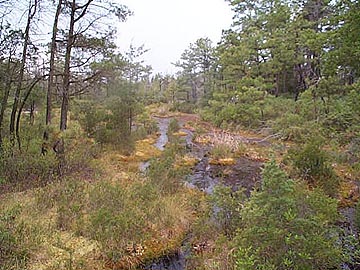
Intro /
Photos / Info /
Growlist / Sales &
Trades / Wanted /
Links /
Contact
New Jersey Pine Barrens Trip - May,
2002
 |
 |
On Monday, May 27th, 2002, I dragged three of my friends on an adventure
to the New Jersey Pine Barrens to see some of our "local" carnivorous plants
in habitat. After almost 2 hours in the car, we stopped at our destination
-Webb's Mill in Ocean County, New Jersey. After drenching ourselves
in insect repellant, we walked through the tiny bit of forest leading to
the bog. For those of you who are not from the area, Lyme Disease (carried
and transmitted by deer ticks) is a potentially crippling disease which
is a serious problem in this area, so proper protection is necessary but
certainly not 100% effective. Webb's Mill is a very accessible bog
which is located in a state forest. As such, it is protected from
habitat destruction and plant collectors. (=Don't even think of going
there and collecting!) By the time we got there, the skies were
very dark and it was obviously going to start raining pretty soon! Several
minutes later, we were in the middle of a thunder storm.
Webb's Mill is a very interesting place. Scattered sphagnum hummocks
rise above a sand base often covered by about an inch or two of water.
This location is a great place to see native Drosera, Sarracenia
purpurea and Utricularia subulata (if not others too). There
is even a boardwalk going through part of the bog, making this the most
visitor-friendly CP habitat I have ever had the pleasure of visiting. This
also helps prevent damage to this fragile ecosystem. The nutrient-poor
soil appears to sustain very little other than CP. Or maybe I just
didn't notice anything else in my quick search for CP! Strangely,
I don't think we saw a single living insect while we were there!
That's right - not a single mosquito bite!
The most fascinating thing to me about this location is that all three species of Drosera present (Drosera filiformis ssp. filiformis, rotundifolia and intermedia) were found growing very close to one another but almost never intermixed. They all seem to have their own special niche in this unique ecosystem. Adult plants of D.filiformis were almost always found in spots only very slightly higher and better drained than the other 2 species. The rotundifolia were found most often in the middle of sphagnum islands and the intermedias on the edge of these hummocks, in the wettest conditions. No hybrids were found in this location although they could have easily been overlooked.
I wish I had more time to study this and other populations but the bad weather
had my friends wishing they were home and I was outvoted! (What wimps!)
Regardless, my observations seem to support a hypothesis I had about
D.intermedia. At the beginning of April a couple years ago,
I took my Brazilian buddy Fernando to a relatively unimpressive but local
D.intermedia spot. Although it had been warm for a couple of
weeks and I thought they would be emerging from their winter hibernaculum
(and therefore easy to find), we couldn't even find a single plant where
there should have been thousands! How frustrating! This location
is usually very wet during the spring but dries up significantly
over the summer. By the time I had almost given up, I took a look
in one of the pools of water and there they were! Plenty of
D.intermedia, emerging from winter buds, totally under water!
I'm thinking that maybe D.intermedia, a species also found in
tropical South America (where it does not form hibernaculum or go dormant),
might need to spend the winter under water where it would be insulated
from temperatures which can sometimes be well below freezing. Please
email me if you have any thoughts on this matter.
Despite my friends desire to stay dry, I managed to buy a little time and
get down and dirty in the bog to take some photos for your enjoyment.
:) - SundewMatt
 |
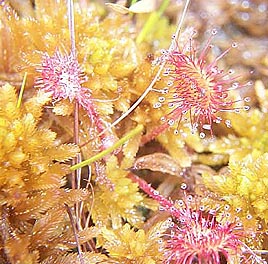 |
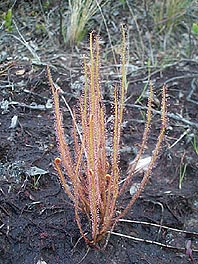 |
Drosera intermedia |
Drosera rotundifolia |
Drosera filiformis ssp. filiformis |
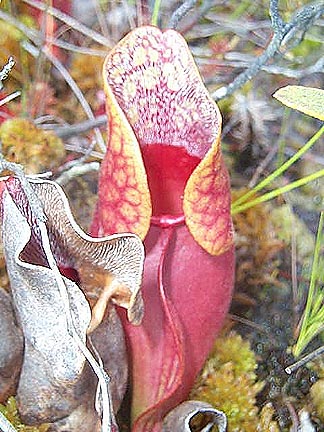 |
|
Sarracenia purpurea pitcher |
Sarracenia purpurea flower |
Intro /
Photos / Info /
Growlist / Sales &
Trades / Wanted /
Links /
Contact
All text and images are Copyright
SundewMatt and may not be copied
without permission.